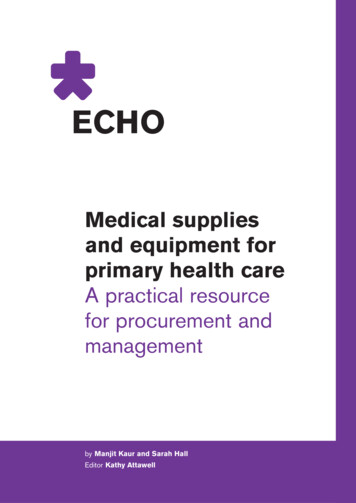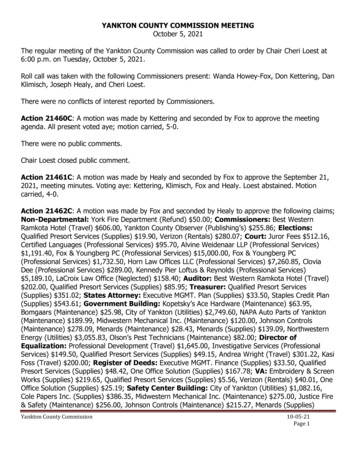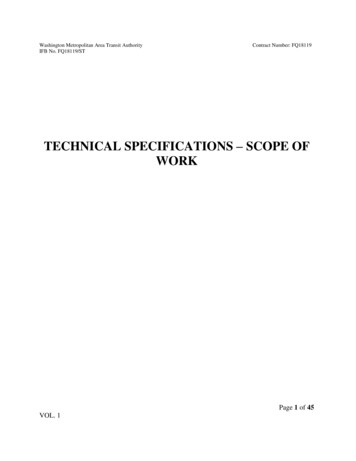
Transcription
New England Water Supplies – A Brief History385 years of drinking water, 125 years of New England Water Works AssociationAbstract:This paper reviews the historical development of New England water supplies in thefollowing areas: Water supply from the settlement of New England through to the 1882 formationof NEWWA Development of water sources through the years Public health issues and the evolution of water quality regulations and watertreatment The growth of distribution systems and their components Disasters, wars and emergency planning Water system management issues over the years A look at the early NEWWA and the growth of the organization Thoughts for the futureSubmitted for publication - September 2006 JournalAuthor:Marcis KempeMassachusetts Water Resources AuthorityCharlestown Navy Yard, 100 First AvenueBoston, MA 02129http://www.mwra.comCover illustration by Martha J. KempePosted on mwra.com 06/2012
New England Water Supplies – A Brief HistoryM. Kempe"Our one great object is mutual improvement."NEWWA’s first President, James W. LyonIntroductionIn 1882, some motivated water supply managers felt that a forum was necessary to exchangeideas and experience. They went on to form New England Water Works Association. This isthe story of a group of far-sighted men who made a difference for their generation and all ofthose that followed. The young but influential organization attracted many brilliant men fromdifferent areas of expertise and different parts of the country. The result was advancement ofwater supply and public health understanding, all with national consequences. New England wastruly a leader in developing the science and engineering that saved lives, kept the vital NewEngland cities safe from water shortages and provided reliable service.My purpose in this history is not just to tell the story of the NEWWA organization and its mostfamous members. Their story has been told and retold at several points during the organization’slife, most notably at the 20th, 50th, 75th and 100th anniversaries. At each of these points,important men who had been present at key moments in NEWWA’s history would provideexcellent histories of the earliest meetings and the wondrous achievements of a youngorganization. I highly recommend rereading these journals as they have many insights into thelife and times of our predecessors. And yet, while I don’t want to diminish the importance ofthis heritage, there is much more to say. There are literally hundreds of water systems in NewEngland, each with a story to tell for their experience in the past 125 years. There are also manycommon themes to this collective experience from which a big picture can be drawn.This paper is meant to discuss the development of New England’s water supplies themselves asdocumented through sources like the NEWWA journal. In the past 125 years, many far-reachingchanges have occurred in everyday life: new technologies; major social, economic andenvironmental changes; different attitudes and expectations from the public, etc. As is seenthroughout history, events are driven by underlying causes and water supply evolution is noexception.It was more than a happy accident that NEWWA formed 125 years ago. It was a necessity thatpublic health issues be resolved and that New England’s growing cities get proper water worksto continue to fuel their prosperity. In the first few years after formation of NEWWA, thenumber of water supply systems doubled. Consider the pressure on this new generation of watersupply managers to step up and do the job properly with no formal schooling in water supply.Consider the huge investment made in these works and the consequences of failure of high riskfacilities like dams and steam pump stations.My goal has been to set down what I have learned from reviewing our history. While theperformance of New England’s water suppliers was notably progressive and successful, notevery decision made by NEWWA’s members was a stroke of genius. Like everyone else, watersupply professionals learn by using their best judgment and then learning from their oftenunavoidable mistakes. In 1882, much of the science and technology that we take for grantedtoday was not adequately understood. The public health community was in the middle of anPage 2 of 157
New England Water Supplies – A Brief HistoryM. Kempeepiphany in understanding the role of bacteria in epidemics. Water treatment was primitive andwater quality was worsening from pollution. The engineering and materials needed to collect,transport and distribute the water were also primitive. Throughout water supply history, fundinghas so often been the biggest factor in decision making and a constraint to necessaryexpansion/rehabilitation work. Many decisions to be made had trade-offs or hiddenconsequences which continues to be the fate of all water suppliers through to the present day.The lesson learned from this review is that by establishing a forum for sharing of experienceamong the operators, engineers, vendors and academics of NEWWA, the optimal improvementof water supply practices was assured and the public that we all serve was protected in the bestway possible.In the interests of consolidating the various facts, I have tried to identify where certaintechnological “firsts” took place as best I could determine. My apologies if I have not givenyour community proper credit.Page 3 of 157
New England Water Supplies – A Brief HistoryM. KempeChapter 1 – Drinking water in the early daysTimeline – Drinking Water Before NEWWANational EventsNew EnglandTextile Industry Industrial Age,InternationalcommerceFarming, fishing,small manufacturingeconomyColonizationspreads, Manynew towns1650Water and windpowered millsRevolutionaryWar1700First Water Works –Boston’s “Conduit”1750Most people rely onwells, cisterns andstreams1772 ProvidenceFirst Supply1755 Bethlehem PA,First Pumped WorksImmigration boom,cities grow rapidlyCholera & typhoidepidemicsCanal Age1800Railroads spreadFirst sewerageCivil WarFirst toilets1850Many larger citiesbegin to buildWater Works19001850’s First steampumps for WaterWorksMany citiesexpandsupply1830’s First castiron pipes in NE1882 NEWWAFormedWater EventsWater supply existed before NEWWA, so a brief review is in order to document water supplychoices made by the earlier practioners.New England waterways were one of the best things about the region, attracting colonists withample water to drink, water for power and water for transportation. The first colonies choselocations on the coast for commerce and travel but were mindful to ensure access to puredrinking water. Their original choices reflected their modest size. Often a clear spring or brookwould be the chosen center of a new community.Water in New England before colonizationNew England was blessed with features that provided much help to development of early watersupplies. For one thing, there were abundant natural ponds and lakes. For another thing, therewas enough elevation change and transmissive soil to provide good recharge to rivers and tocreate springs and artesian groundwater flow. Given the abundance of fresh water in the region,Native Americans camped near it but needed no irrigation or supply works as in drier parts of thecountry.New England’s river water could be colored and slightly turbid in places from passage throughswamps but was generally clearer than that from other parts of the country in that it carried littlesediment. The water was generally noted by colonists as being soft and “sweet”. Soils werepredominantly glacially created with more sand and gravel deposits than clay. With littlelimestone, the water had very little hardness and was somewhat corrosive.New England’s rivers also had more elevation drop than many other parts of the country. Thissingle feature made the industrial revolution possible since the resulting water power wasinexpensive to develop and plentiful throughout the region. Mills sprang up wherever it wasPage 4 of 157
New England Water Supplies – A Brief HistoryM. Kempepossible to install a dam and diversion works. Grist mills and sawmills were the forerunners ofmuch more elaborate manufacturing processes that were driven by water wheels or turbines.This guided much of New England’s growth since the worker population followed mill growth.Rainfall in New England was also fairly consistent throughout the year and relatively plentiful.In spite of adequate rainfall, farming in New England never grew to the size and importance ofthe U. S. mid-west since the terrain was hilly and the soil quite rocky. Extensive irrigation workswere not necessary for the farming that did develop.The English colonies begin and spread – 1620 toRevolutionary WarBefore New England was settled, Virginia had the firstpermanent English colony in 1607. There had beenexplorations of the New England coast by many nationsbut there was little interest in colonization since therewere no easy riches to plunder. It wasn’t until thebeginning of the 1600’s that Europe began to see theNew England area as source of raw materials forEuropean industries. Desirable resources includedExample of old pump well –crops, wood, fish, furs and other items in demand in theAdams House - Quincy MAEuropean economy. At this point, colonization becamea privatized effort where colonies were chartered by investors with hopes of significant financialreturns. This perhaps explains the entrepreneurial spirit that shows up again when water suppliesare needed and private investors step up to develop the first water works.English colonists settled in Plymouth MA in 1620, thenthe Cape Ann area of Massachusetts in 1625, and BostonMA in 1630. These English colonies then spread in alldirections in New England, founding offshoots in parts ofRhode Island, Connecticut, New Hampshire, southernVermont, and Maine (part of Massachusetts until well intothe 1800’s).The English weren’t the only ones interested in NewEngland. The Dutch settled in New Amsterdam around1613 and tried to extend their way into Connecticut. TheFrench settled in northern Maine and Canada in the1620’s, reaching down to Northern Vermont along LakeChamplain. Both the French and Dutch were eventuallyevicted from present day New England but left much inthe way of heritage, most notably the names of manyTypical household dug well from 1700’swith bucket on rope pulleytowns. State boundaries for present day Massachusetts,Rhode Island, Connecticut and New Hampshire were set by English rulers but not without somecontroversies. Vermont’s boundaries were eventually set as the new state was added after theRevolutionary War. Maine was split from Massachusetts later in pre-Civil War days in a bit ofmaneuvering to balance slave states with non-slave states.Page 5 of 157
New England Water Supplies – A Brief HistoryM. KempeFrom a water supply standpoint, all settlement in New England was by European settlers andreflected the rudimentary understanding of water, public health and water use technologies thatwere present in Europe at the time. This meant that the same European habits of infrequentbathing and poor sanitation were transferred to the colonies. The colonies were merely startingwith a cleaner slate in terms of having unpolluted water sources to start where Europe hadalready fouled the waterways near its cities. Water supply technologies such as dug wells andthe use of wooden and lead pipes were the rule. Water and wind powered mills provided thepower source for anything that could not be accomplished with hand tools.All early New England cities were coastal in nature, being located in coastal ports (e.g. BostonMA, Portsmouth NH, Portland ME, New Haven CT) or upstream on a navigable river (e.g.Hartford CT, Providence RI, Bangor ME). Even Burlington VT followed this course in that itwas settled on a navigable lake. These choices were necessary to allow shipping and commercebut it made life interesting for future water supply planners when residents eventually outgrewlocal water sources. Other smaller towns popped up at many locations inland as farmers spreadand generally bordered on an available river or stream.The First Water SourcesThe first colonies obviously had the first water sources, some of which have been memorializedby the community’s residents. These sources were merely a place to bring a bucket and carryhome a bucketful or two during the day. Water use habits of the colonists were fairly austere,perhaps several gallons per day per resident. The effort required to bring that amount of weight afair distance made anything other than essential uses difficult. This was a pretty effectivedisincentive on bathing and washing and contributed to the general lack of proper sanitation.Everycommunity had acentral watersupply point, beit a spring, a wellor a river. Thesewere notengineeredfacilities, but arenoteworthynonetheless. Afine example of amonument to afirst drinkingwater sourcecelebrates thewater supply ofthe originalPlymouth colonyin“Freely drink and quench your thirst,Here drank the Pilgrim Fathers first”Plymouth’s first water source was Town Brook,near the current Mayflower dockPage 6 of 157Plymouth’s monument to the first water source
New England Water Supplies – A Brief HistoryM. KempeMassachusetts. A drinking fountain was dedicated in 1915 at a location on Main Street aboveTown Brook. The brook, just south of the center of town, was fed from Salton Pond andprovided the residents of the town center with potable water until the first water works was builtin 1855.Similarly, Providence commemorated its first watersource, the Roger Williams Spring, named for thefounding father of Providence Plantation, the colonyestablished by Roger Williams after his exit fromMassachusetts in search of religious tolerance. This site,at North Main Street, was designated by AWWA as aNational Historic Water Landmark.Boston residents put up a plaque at the location of theMonument to Roger William’s spring,Providence’s first water source“Great Spring” at present day Spring Lane, which fedthe bulk of the residents in the original community. Thisspring was the reason why the colonists chose the location that they did after first landing inpresent day Salem and Charlestown only to find the water sources to be lacking. The “GreatSpring” became the center of the rapidly growing community that for a good while was thelargest city in the colonies.It’s a pity that the location of the “Conduit”isn’t clearly marked at its Dock Squarelocation near Fanueil Hall. This 1652 site wasthe first actual water works in the US in that itwas more than just a place to dip a bucket. Itsoriginal purpose was as much to provide fireprotection in an area of dense wooden housingas it was meant to supply drinking water.Several uphill springs in the area wereconnected by means of wooden pipes to a 12’square cistern-like structure in Dock Squarethat would provide plentiful water for allneeds, replenished much more rapidly than adug well. Once the pipes were laid, it isknown that selected homes, those of the peoplethat financed the venture, were then tapped inand provided with running water. Thus, thisearly water works had intakes, pressure piping,distribution taps and a storage reservoir, albeiton a very modest scale. It helped significantlyin subsequent conflagrations in theneighboring areas and served well into the1700’s before becoming too fouled to use. Asection of old wooden main from this sitegraces the NEWWA lobby.Page 7 of 157Section of the 1652 “Conduit” pipe, located inNEWWA lobby
New England Water Supplies – A Brief HistoryM. KempeThe desire for theconvenience ofrunning water in thehome wasn’t the onlydriving force that ledto development ofwater works. Theneed for fireprotection wasequally important,perhaps even moreimportant at thatpoint. Before brickmanufacturing wasdeveloped, allhousing in theThe “Conduit”, Boston’s 1652 supply, the first Water Works in the U.S.colonies was made ofwood, including inmost cases, the chimneys. A mud coating was the only protection against flames. Once a firestarted, it could very well spread from house to house via the thatched roofs. Colonial homeswere generally required to keep cisterns, barrels or other water containers filled for quickresponse to prevent conflagration. Fire protection was more carefully regulated than water usageor quality, with regulations being adopted to make housing more fire resistant and requirementsput on homeowners to be ready to fight fire at any time. Even after brick construction and slateroofs were the norm, wood framing and close proximity in central areas meant a good supply offire fighting water would be needed.Examples of wooden pipes from Boston’s Jamaica Pond AqueductMoving water around in pipes required workable materials. Colonists had wood in abundanceand had knowledge of how to make and join wood pipe sections, a fairly common practice inEngland. Metal for pipes had to be imported at first until eventually iron works were built.Metal for water pipes was limited to lead initially but in the early 1800’s foundries had been ableto produce iron plate that could be rolled, riveted and coated with cement to form wrought ironpipe. The production of cast iron pipe in the US began in the early 1800’s but the cost was highuntil improved production methods made it more economical to use by the late 1800’s.Page 8 of 157
New England Water Supplies – A Brief HistoryM. KempeWho had the earliest water works? The following table shows the first wood pipe systems, someof which date back well over 200 years.Water systems built entirely of wood pipes:City/TownState Date SourceBostonMA 1652 SpringsProvidenceRI 1772 SpringsSalem & Beverly MA 1796 Well on Gallow's HillPortsmouthNH 1798 SpringsWorcesterMA 1798 SpringsPeabodyMA 1799 SpringsHaverhillMA 1801 Springs/pondsNew LondonCT 1802 SpringDrewsvilleNH 1804 SpringBridgeportCT 1818 Springs on Gold HillHanoverNH 1820 Springs/wellsCambridgeMA 1837 Springs to a reservoirSpringfieldMA 1843 ReservoirGorhamNH 1873 SpringsCommentsWood pipes also used in 1796 Jamaica Pond systemProvidence Water Co., Rawson Fountain SocietyBuilt by Daniel FryePortsmouth Aqueduct Co.Built by Dan'l Gooding, later use of Bell's PondFrom Salem & Danvers Aqueduct Co.Haverhill Aqueduct Co.Aqueduct Co.Smallest village with a water system in 1882Built by Rev. Elijah WatermanHanover Aqueduct Co.Cambridgeport Aqueduct Co. supplied a few familiesBuilt by Chas. Stearns, taken over by Springfield Aq. Co.Alpine Aqueduct Co.Note that the use of wood continued well after metal pipe had become practical and affordable.Wood pipe was still actively installed and used in rural areas like northern New England wellinto the 1900’s. On the other hand, contrary to urban legend, wood pipes in the cities have notbeen in use since the transition was made to iron pressure pipes in the mid 1800’s. Anoccasional piece of wood pipe may be unearthed in some construction project but modernpressures would have blown it apart long ago, had it been left in service.Not all of the early water works used wood. Given very low usage, some opted to used a leadpipe of up to 2” or so in diameter which, though limiting, at least may have been easier to keepfrom leaking than wood. When cast iron first appeared, the size and strength issues were nolonger an issue, allowing more capacity and higher pressures for the growing water demands.The First Metal Pipe Systems through 1850CommunityStateYear metal pipe nburyNorth ConwayPeabodyNew LondonWorcesterChicopeeBellow FallsHyde 618291832183318331834184018451845184818501850Type – Lead/Wrought Iron/Cast IronLead PipeLead PipeUnknownLead PipeWrought IronLead PipeCast IronWI & CIWI & CIWrought IronWI & CICast IronWI & leadWI & leadPage 9 of 157Source at the timeNeck Pond, Munjoy HillSpringsSprings/pondSprings/wellsCold SpringSpringsArtist's BrookSpring PondMill PondBell's PondBrookLake MinardSpringsDudley Brook
New England Water Supplies – A Brief HistoryM. KempeThe very early water works from the 1600’s and 1700’s were by no means complete systems inthe sense that we have today. Given the large costs incurred by the private water companies, theexpense of a connection was only affordable by the well-to-do and there were no governmentalrequirements to serve all customers. The poor could always walk to a public well or cistern. Therich folks on the hilltop could have their own well developed or pay a water seller for deliveries.Access to water was also a function of location since the pipes did not serve all areas. Often thesource was barely higher than the area being served so delivery pressures and volumes werelimited. Wooden pipes were typically 2”-4” in diameter and early lead pipes were 2” or less socapacities were never what we would consider as robust in this period. Expectations were lowand outages were frequent, especially since the wood pipe was notoriously prone to breakage.Early sanitationPrivies and outhouses were the rule in the 1600’s and1700’s. In the more densely settled areas, the facilitieswere often located in the basement. The waste was heldin a tank or pit until the “Nightmen” came to reclaim itfor its fertilizer value.With the poor understanding of disease, no specialprecautions were taken around water supply sources.Animals roamed freely, adding copious amounts ofwaste to drainage that ended up in water sources. Peopleoften disposed of unwanted items, ranging from trash todead animals, into the water body from which theydrank. Early industries such as slaughterhouses andtanneries discharged wastes to whatever water body washandy. Cemeteries were located close to urban areas andoften in the watershed areas of water sources. Anexcellent example of this is found on Boston’s FreedomPlaque on Spring Lane in BostonTrail where “The Great Spring” on Spring Lane is foundone block downhill of 2 graveyards, the Granary BurialGround and King’s Chapel Burial Ground. Needless to say, many early water supplies were in astate of continual contamination. Only when the aesthetics of a fouled supply would becomeunpleasant were residents discouraged from using it.Epidemics were frequent and deadly. Communicable diseases like smallpox had visited most ofNew England with quarantine the typical control strategy. Yellow fever was a seasonal scourgein swampy mosquito areas. Life expectancy was much lower than at present even without thewaterborne illnesses of the period. With the close quarters and poor hygiene in poor areas,bacterial and viral illnesses essentially created a reservoir of disease within the community andthe wastes from the infected population would be circulated to others, often via the water supply.Page 10 of 157
New England Water Supplies – A Brief HistoryBefore “germ theory” was advanced as a cause ofsome diseases, there was a widespread belief thatdangerous vapors from unclean areas, called“miasmas”, were the cause. There was also a beliefamong many that poverty, uncleanliness and diseasewere connected as some sort of punishment for theunworthy, consistent with the religiousrighteousness of the times. These believers had theexpectation that one of water supply’s best purposeswas for washing down streets and tenement areas towash away the disease lurking there. Oldengravings from the period show horse drawn waterbarrels being used for street cleaning. Of course,the horses themselves put back as much waste aswas washed away at times. Empirical evidenceoften connected poor water aesthetics togastrointestinal illnesses at some water sources withresulting loss of confidence among water consumers.Still, with limited population and industry, most of therivers and large water bodies around New Englandremained clean through the 1700’s and water qualitytroubles were more local than regional.M. KempeSome famous names that you may notknow as early Public Health officials:Paul Revere – First head of Boston’sPublic Health Board in 1799.Benjamin Franklin – In the 1730’s, hewas the first head of Philadelphia’s streetcleaning department, a critical publichealth service given the nature and volumeof wastes in colonial days. He later wenton to be a strong advocate for seweragecleanup in Philadelphia. He also startedthe first fire company there in 1736.Famous People affected by WaterborneDisease: Prince Albert of England died in1857 of typhoid. Abigail Adams, wife of PresidentJohn Adams died in 1818 oftyphoid. President Zachary Taylor died ofcholera in 1850. George Washington was affected bydysentery but survived. Louis Pasteur, the influentialmicrobiologist, lost two daughtersto typhoid.The Influence of Europe on American WaterEngineeringNew England settlers had the benefit of English waterengineering examples from which to model theirefforts, a mixed blessing at best. Private watercompanies had been supplying London from as early as 1213. As many as 9 separate watercompanies supplied parts of the city with water, some from adjacent springs or wells and somedirectly from the Thames. One water company used water wheels housed in the famous“London Bridge” to pump Thames water up to an uphill cistern for distribution. Of course, all ofthe Thames withdrawals had serious water quality and sanitation problems, with one unfortunatewater company having an intake directly opposite the largest London sewer. With the sanitaryproblems created by the extremely dense population of this old city, the Thames River wasalready grossly polluted during this period and featured such colorful periods as the “GreatStink” of 1858. Life expectancy in mid-1800’s London was down to 26 years. One notablewater supply effort was the “New River”, an 18 mile canal built by Sir Hugh Middleton in 1619that was both an heir to the Roman aqueduct legacy and a forerunner of the modern waterdiversion from a protected upland source. London would later come to be a leader in sanitaryreform but during the early 1800’s, the example set for the US was not a particularly progressiveone. Other European cities had similar experiences and had the disadvantage of having long agopolluted their available waters.Page 11 of 157
New England Water Supplies – A Brief HistoryM. KempeOn the plus side, there was an active scientific community throughout Europe studying suchwater supply topics as hydraulics and water treatment. Scotland had implemented the earliestfiltration of a community water system and France had made many advances in optimizing waterwithdrawals from a river through early bank filtration systems. European water engineers wouldcontinue to be a resource to US engineers during the 1800’s. An example of this was noted civilengineer Charles Storrow’s major 1830 work “A Treatise on Hydraulics” which was acclaimedin the US as being the best work of its day but was essentially just a compilation of what he hadlearned in his studies abroad.Water supply in the rest of the US, New York, Philadelphia, BaltimoreOutside of New England, the major US cities were beginning to seek water supplies. Onenotable early effort is Bethlehem, PA, home to a Moravian community that developed a pipedwater supply in 1755 that featured pipes, hydraulically powered pumping and an above groundstorage tank to supply homes with running water. The pumping was done with wooden positivedisplacement pumps and supplied water through wooden pipes. ASCE has recognized this earlysystem as a National Historic Landmark.The first significant municipal systemwas the Philadelphia water supply. Thecity sits at the confluence of theDelaware and Schuylkill Rivers, theformer being tidal and the latter havingmore elevation drop and better waterquality. In 1801, Benjamin Latrobe ofPhiladelphia designed and built the firstlarge scale steam engine for municipalwater pumping and used it with the firstmunicipal cast iron pipes to pump fromthe Schuylkill River to a storagereservoir supplying the city with cleanFairmount Waterworks in Philadelphiawater. Wooden pipes were still theHydraulic pumps in the building to the right supplied water to openreservoirs on the hill where the Philadelphia Museum of Art now sitsmainstay of the distribution system fromthe reservoir to the customers. The steam engine eventually proved to be difficult to manage andexpensive, leading to a rethinking and reconstruction of the supply works in 1822. The newfacility, the Fairmount Waterworks, featured hydraulic pumping using water wheels; it servedthe city proudly for the rest of the 1800’s. This facility was beautifully designed in aneoclassical style that resulted in its current use as part of the Philadelphia Museum of Art aswell as being designated as an AWWA and ASCE National Historic Landmark. In its day, thePhiladelphia Works were considered the finest in the country until it suffered the same fate asmany supplies of its day, i.e. the source water quality degraded to the point that other suppliesmade more sense.Since the days of the Dutch settlements of the 1623, New York had been supplied by wells andponds on Manhattan Island. Water quality of these sources was clearly inferior and availabilitywas much too limited for the island’s population, but the politics of obtaining a more plentifulsupply were difficult to overcome. It wasn’t until 1842 that the flow of the Croton River wasdammed and diverted via aqueduct to the center of Manhattan to feed a network of cast iron andPage 12 of 157
New England Water Supplies – A Brief HistoryM. Kempewooden pipes. The Aqueduct Bridge over the Bronx River is a particularly notable example ofan aqueduct in the old Roman style.Washington and Baltimore similarly constructeddiversion works and aqueducts from an upstreampoint of their rivers to supply the communitymainly by gravity. Other western cities that didn’thave the advantage of a river with significantelevation drop had to wait for re
Vermont, and Maine (part of Massachusetts until well into the 1800's). The English weren't the only ones interested in New England. The Dutch settled in New Amsterdam around 1613 and tried to extend their way into Connecticut. The French settled in northern Maine and Canada in the 1620's, reaching down to Northern Vermont along Lake .










